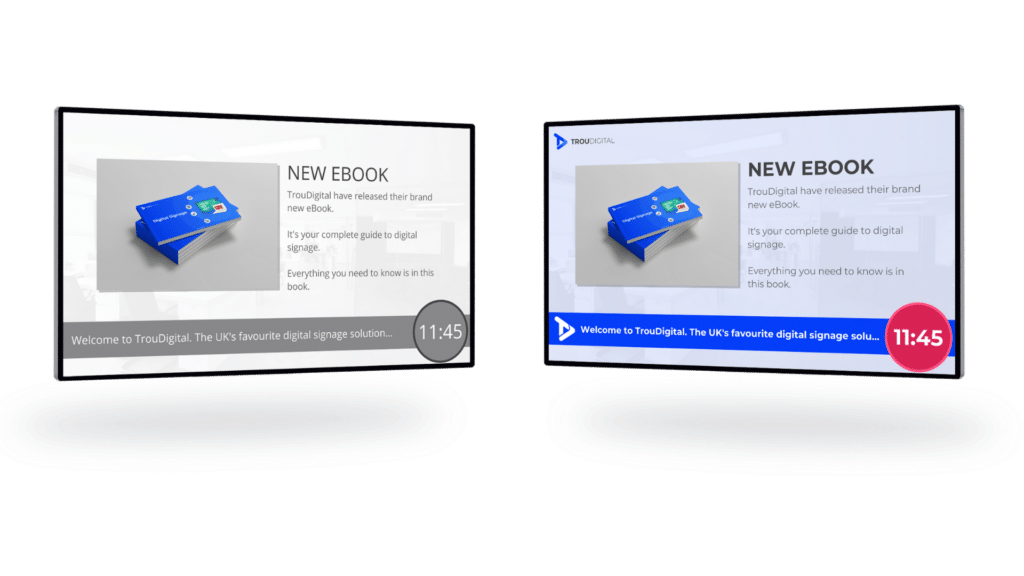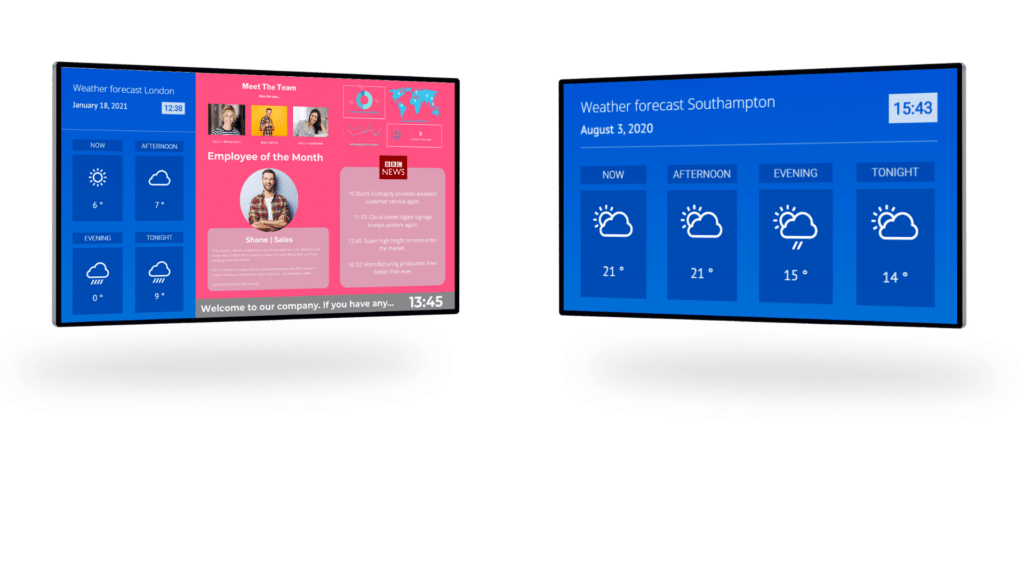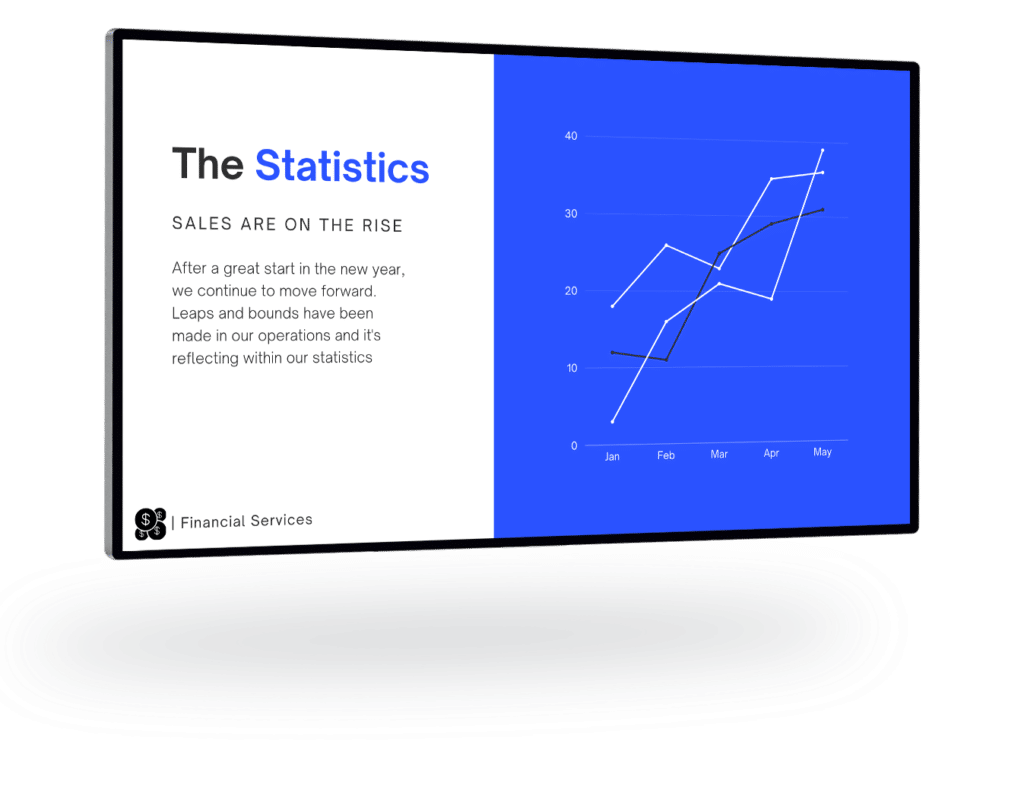Digital signage content design should be at the forefront of your digital signage planning. Digital signage is a highly visual marketing channel. Therefore, how your content looks and reads will determine the success or failure of your campaign.
In this blog we give you 5 game-changing tips that will change your digital signage content design game.
Need some digital signage inspiration? Check out our complete digital signage content examples guide.
1. The Importance of Branding Your Digital Signage Content
Branding is an extremely important aspect for all businesses. It helps customers emotionally connect with your organisation, provides value, and helps you stand out amongst the competition.
Branding is important both internally and externally. From employee training materials and coffee cups to social media and out of home advertising, branding appears everywhere. Consistent branding allows your organisation to improve its brand awareness, brand identity, and brand recognition. After a period of time, this helps current and potential customers assign a level of trust or value when they see your brand colours, logos, or jingles, etc. This inevitably leads to more sales or leads.
The importance of branding extends to your digital signage content design. If your screen content isn’t branded to your organisation your audience is less likely to relate it back to your brand. This means you potentially lose out on the benefits of assigned trust and value levels your audience had for your organisation. In addition to this, your audience may see the content as irrelevant and won’t pay attention to it. Therefore, when designing your content, keep your brand guidelines close by. Ensure you are using your organisation’s most up-to-date logos, fonts, and colours.
It can be a good idea to create some nicely branded templates with your digital signage studio. You can also do this using 3rd party software such as Canva, Photoshop, or your preferred design tools. Some digital signage providers may already have these available on request (we do!). These templates can be saved as image files and uploaded into the background of your content. Using your digital signage software you can then embed images, text, and widgets to bring your content and brand to life.

2. Sometimes Less Is More
Sometimes, when we have so many good things to say we want to let everyone know and say it all. However, when it comes to graphic and content design usually less = more.
Trying to fit everything into one creative is going to look messy and cluttered. You’ll quickly find that if you try to squeeze everything onto one content slide your overall message gets lost. In addition to this, your audience gets confused at the behemoth of an ocean of information they have to take in. They don’t know where to look and may quickly get disinterested.
So what’s the solution? Picking an overall topic or theme for each of your creatives is a good place to start. So instead of trying to display eight topics on your screen try to narrow it down to one or two. This helps our content and message stand out and allows the audience to digest it easily. For example, instead of having a creative that displays a menu, the weather, meet the team, live news, messages, slideshows, and an employee of the month, try to split these into individual creatives. Therefore, you would have one creative for the weather, one for employee of the month, etc. This helps your message stand out and keeps your content looking great.

3. Remember Your Target Audience
Sometimes great looking digital signage content comes from being able to successfully align designs with it’s intended audience.
Imagine you’re designing digital signage content for internal communications for a corporate office. The intended target audience is likely to be accomplished business professionals. Therefore, you will want to create content to suit this audience. For example, you wouldn’t want to have bright colours or cartoons on your digital signage content. Instead, the content should heavily follow brand colours and lay content out in a neat and professional manner.
Thinking of what your target audience’s needs are is also highly important. For example, the needs of a screen being used in a breakroom will be very different to those being used at a bus terminal. Therefore, it’s important to plan out what your audience’s needs are, and how your content is going to meet them.

4. Font Size It’s a Big Deal… Literally
Digital signage is a highly visual form of marketing and communications. To do it’s job correctly all the content that gets deployed to your screens needs to be easily seen. For example, if you have a creative that is about showing new project pictures for a new building. You want all the project pictures to be easily visible, otherwise the content isn’t doing it’s job.
This also applies to text. In many cases, digital signage content involves headings, body text, descriptions, or CTA (call to action). These will need to easily legible to ensure the message is being received clearly. If the text can’t be read, your audience may be confused, won’t absorb the message, or won’t complete the CTA.
Therefore, it is important to ensure all text going on your content is going to be easily legible when deployed to your screens. It’s important here to factor in viewing distance. For example, if the average distance for viewers is 10m the font size will need to be much larger than if the average distance was 2m.

5. Give Direction With a Call To Action
In marketing, strong CTAs are vital if you want to see results. It gives the user/audience a direction to go. Particularly if they want to learn more, sign up or buy your product, etc. Without a CTA users may look at a marketing message and think “okay good” and proceed to click/walk away. However, a CTA tells the user what to do next and drives them through the sales funnel.
The same applies to digital signage content design. Designing your content without clear CTAs is almost like building a road to nowhere. For example, your screen may say “NEW RED SHOES” with a picture of the new product. Potential buyers look at this and don’t take any further action. However, if the screen said “NEW RED SHOES – USE CODE: RED20 FOR 20% OFF ONLINE”, action is likely to be taken. Customers will see the message and will use the code online if they are interested. These codes are also a great way of measuring digital signage success.
CTAs exist in many fashions. They can be buttons (for interactive digital signage), text, and audio. When creating your digital signage content it is critical to make your CTAs as clear as possible. You want to draw as much attention to the CTA as possible as it’s the next step you want your audience to take. Therefore, using techniques such as white space or giving the CTA it’s own section is a good start. In addition to this, it is important to plan out the journey your audience will take upon answering the CTA. Plan how you will track conversions, how the audience receives information etc.

